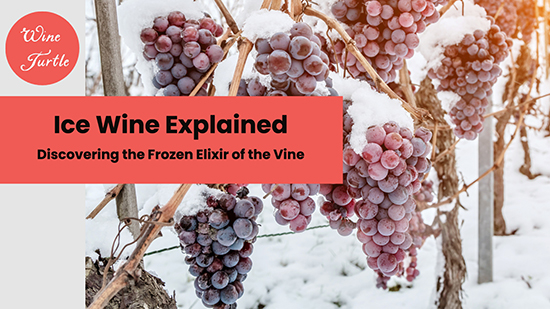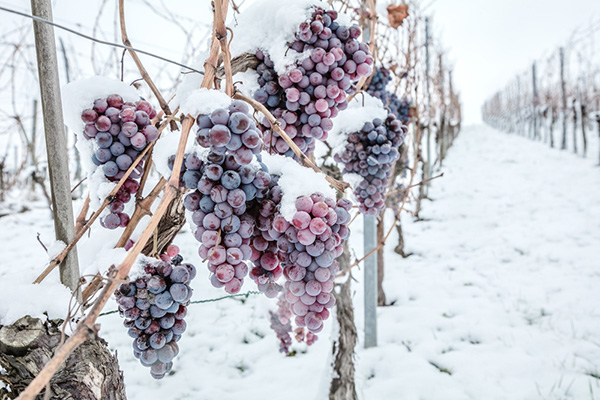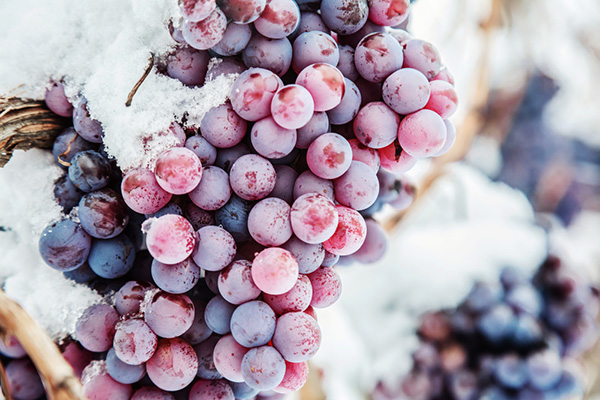Ice Wine Explained: Discovering the Frozen Elixir of the Vine

Unveiling the Magic: What is Ice Wine?
Ice wine, also known as eiswein, is a luxurious dessert wine produced from grapes that have been left on the vine to freeze naturally.
This freezing process concentrates the sugars and flavors, resulting in a sweet, rich, and complex wine that is prized by wine enthusiasts worldwide.
Ice wines generally have a residual sugar content ranging from 150 to 320 grams per liter, making them significantly sweeter than most table wines.
However, the sweetness is often balanced by the wine's acidity, creating a harmonious and pleasant taste.
To put that into context, Coca-Cola has a sweetness level of around 108 grams per liter (g/L). That’s how sweet ice wine can be!

Why is Ice Wine So Expensive?
Ice wine production is a delicate and risky process, as the grapes must be picked and pressed while frozen, usually in the early morning hours.
The weather conditions must be just right, and if they aren't, an entire season's crop can be lost. This rarity and the labor-intensive process contribute to the higher cost of ice wine.
Only true ice wine uses grapes that are picked while frozen on the vine. Wine made from grapes frozen after the harvest is simply dessert wine.
The History of Ice Wine
The invention of ice wine is believed to have been somewhat accidental. The precise origins are unclear, but the first documented production of ice wine dates back to Germany in the late 18th century, specifically in the Rheingau region in 1794.
According to historical accounts, the winter was unusually cold that year, causing the grapes to freeze on the vine before they could be harvested for traditional winemaking.
The winemakers decided to press the frozen grapes anyway, discovering that the freezing process concentrated the sugars and flavors within the grapes.
This led to the creation of a unique, sweet, and intense wine that came to be known as ice wine or "eiswein" in German.
Crafting Liquid Gold: How Ice Wine is Made
Producing ice wine is a delicate and labor-intensive process that requires specific weather conditions and careful timing.
Here is a detailed explanation of how ice wine is made:
- Selecting the grapes: Winemakers need to use grapes that have 2 key attributes: High acidity and the ability to withstand very cold temperatures. Riesling, Vidal Blanc, and Cabernet Franc are among the most common varieties used.
- Waiting for the freeze: Grapes are left on the vine well past the traditional harvest time, usually until the first hard frost arrives. The temperature must drop to around 17-20°F (-8 to -6°C) and remain consistent for several hours to ensure that the grapes freeze through completely. The timing of the freeze is crucial, as too early or too late can compromise the quality of the wine.
- Harvesting: The frozen grapes are handpicked, typically during the early morning hours when the temperature is coldest. The harvest must be completed quickly to ensure the grapes do not thaw, as thawed grapes cannot be used for ice wine production. It’s a very strict process.
- Pressing: The frozen grapes are pressed immediately after harvesting. The cold temperature causes the water content within the grapes to freeze, leaving behind a concentrated juice that is rich in sugar, acidity, and flavor. This concentrated juice is collected and separated from the ice crystals during pressing.
- Fermentation: The concentrated juice is then fermented in temperature-controlled tanks or barrels. The high sugar content and low temperatures make fermentation a slow process, sometimes taking several months to complete. The specialist yeast strains used for ice wine fermentation must be able to tolerate these high sugar levels and low temperatures.
- Stabilization and clarification: After fermentation, the wine undergoes stabilization and clarification processes to remove any remaining yeast or other solids, ensuring a clear and stable final product.
- Aging: Ice wine is typically aged in stainless steel tanks, oak barrels, or a combination of both, depending on the desired style and flavor profile. The aging period can vary from a few months to several years.
- Bottling and labeling: Once the winemaker is satisfied with the ice wine's flavor and balance, it is bottled and labeled for sale. Ice wine is often sold in smaller bottles (375ml) due to its richness and the limited quantity produced.

Grapes Used to Make Ice Wine
There are a variety of grapes used to make ice wine and they all share a few key features. They are tough, resistant to the cold, and have good acidity.
Riesling
Riesling is one of the most popular grape varieties used for making ice wine, particularly in Germany, where ice wine originated.
Riesling grapes are highly versatile and well-suited to ice wine production due to their high acidity and ability to withstand cold temperatures.
Riesling grapes produce wines with intense fruit flavors, such as apricot, peach, and citrus, accompanied by a balanced acidity that cuts through the sweetness, creating a harmonious and elegant wine.
Vidal Blanc
Vidal Blanc is a French-American hybrid grape variety that has become a popular choice for ice wine production, especially in Canada.
The grape's thick skin and hardy nature make it resistant to cold temperatures, allowing it to thrive in icy climates.
Vidal Blanc ice wines are characterized by their tropical fruit flavors, such as pineapple and lychee, along with honey and floral notes.
The grape's high acidity helps balance the wine's sweetness, resulting in a rich and complex flavor profile.
Cabernet Franc
Cabernet Franc is a red grape variety that is less common in ice wine production but has gained popularity in recent years, particularly in North America.
As a grape that ripens earlier than other red varieties, Cabernet Franc is well-suited to the colder climates where ice wine is produced.
When used for ice wine, Cabernet Franc grapes yield wines with flavors of red fruit, such as raspberry and strawberry, accompanied by herbal and spicy notes.
The resulting ice wines are often deep in color and exhibit a balance of sweetness and acidity that makes them stand out among dessert wines.
Notable Ice Wine Regions
Some of the most famous ice wine regions include:
Niagara Peninsula, Canada
The Niagara Peninsula, located in Ontario, is one of the world's leading ice wine producers.
The region's climate, with cold winters and a relatively mild growing season, creates ideal conditions for ice wine production.
The most commonly used grape varieties in this region are Vidal Blanc and Riesling, but other varieties such as Cabernet Franc are also used.
The Niagara Peninsula is home to numerous award-winning wineries, including Inniskillin, which has garnered international acclaim for its ice wines.
Rheingau and Mosel, Germany
Rheingau and Mosel are two of Germany's most famous wine regions, and they are also the birthplace of ice wine.
With a long history of winemaking dating back to Roman times, these regions have a rich tradition in producing high-quality wines, including ice wine.
Riesling is the predominant grape variety used for ice wine production in these regions, and the resulting wines are known for their exceptional balance of sweetness and acidity.
Notable German wineries producing ice wine include Schloss Johannisberg and Dr. Loosen.
Burgenland, Austria
Burgenland, situated in eastern Austria, is known for its diverse range of wine styles, including ice wine.
The region's unique climate, characterized by hot summers and cold winters, provides the necessary conditions for ice wine production.
Austrian ice wines, primarily made from Grüner Veltliner and Welschriesling grapes, are renowned for their vibrant acidity and rich flavors.
Weingut Kracher is one of the most famous wineries in Burgenland, producing outstanding ice wines that have garnered international recognition.
Finger Lakes, United States
The Finger Lakes region in upstate New York has gained a reputation for producing high-quality ice wines, thanks to its cold winters and moderate summers.
The deep lakes in the region help to moderate the climate, providing the necessary conditions for ice wine production.
While Riesling is the primary grape variety used for ice wine in the Finger Lakes, other varieties such as Vidal Blanc and Cabernet Franc are also grown.
Notable wineries in the Finger Lakes producing ice wine include Hermann J. Wiemer Vineyard and Casa Larga Vineyards.
The Test of Time: Can You Age Ice Wine?
Ice wine can indeed be aged, with some varieties developing even more complex flavors over time.
High-quality ice wines can be aged for up to 10 years, though most are best enjoyed within 5 years of bottling.
A Symphony of Flavors: Food Pairings for Ice Wine
Ice wine is versatile when it comes to food pairings, as it complements both sweet and savory dishes.
Some popular pairings include:
Fruit-Based Desserts
Fruit-based desserts, such as fruit tarts, cobblers, or sorbets, make excellent pairings with ice wine because they share a natural affinity for fruit flavors.
The sweetness and acidity of the ice wine complement the fruity and tangy elements of the dessert, enhancing the overall taste experience.
Additionally, the concentrated fruit flavors in ice wine can highlight the fresh fruit flavors in the dessert, creating a harmonious pairing that elevates both the wine and the food.
Cheese
Pairing ice wine with cheeses, such as blue cheese or aged cheddar, is a popular choice because the contrasting flavors and textures create a delightful balance on the palate.
The sweetness of ice wine cuts through the richness and saltiness of the cheese, while the cheese's creamy texture and strong flavors provide a counterpoint to the wine's intense sweetness and acidity.
This combination results in a dynamic pairing that showcases the best qualities of both the ice wine and the cheese.
Foie Gras
Foie gras, a luxury food made from the liver of a fattened duck or goose, is often paired with ice wine due to the complementary flavors and textures.
The rich, buttery texture and savory taste of foie gras contrast with the sweetness and acidity of ice wine, creating a harmonious balance on the palate.
The intense flavors of both the wine and the foie gras are enhanced by their pairing, elevating the dining experience to new heights.
Spicy Asian Cuisine
Pairing ice wine with spicy Asian dishes, such as Thai or Szechuan cuisine, might seem counterintuitive, but the combination can be surprisingly successful.
The sweetness of ice wine helps to cool the palate and counteract the heat of the spices, while the wine's acidity cuts through the richness of the dish.
The intense flavors in both the food and the wine are accentuated by this pairing, creating a unique and enjoyable taste experience that showcases the versatility of ice wine.
Savor the Experience: 3 Recommended Ice Wines to Try
Keen to get started with some great ice wine? Here are some awesome bottles to try.
Inniskillin Vidal Icewine, Niagara Peninsula, Canada ~ $60 (375ml)

Inniskillin Vidal Icewine is a luxurious and renowned dessert wine hailing from the Niagara Peninsula in Canada.
This ice wine is made from the Vidal Blanc grape variety, which is known for its thick skin and resistance to cold temperatures.
Expect intense tropical fruit flavors, such as pineapple and lychee, accompanied by notes of honey and floral undertones.
The wine's vibrant acidity balances the sweetness, creating a rich and complex taste experience. Inniskillin is a leading producer of ice wine, and this Vidal Icewine is an exquisite example of their expertise.
Dr. Loosen Eiswein Riesling, Mosel, Germany ~ $55 (375ml)

The Dr. Loosen Eiswein Riesling is a delightful ice wine produced in Germany's famous Mosel region.
Made from the versatile Riesling grape, this eiswein boasts concentrated flavors of apricot, peach, and citrus fruits, with a touch of minerality that is typical of the Mosel region.
Its high acidity and intense sweetness are beautifully balanced, making for an elegant and refreshing dessert wine.
Dr. Loosen is a well-respected winery, and their Eiswein Riesling showcases the exceptional quality of German ice wines.
Weingut Kracher Eiswein Cuvee, Burgenland, Austria ~ $40 (375ml)

The Weingut Kracher Eiswein Cuvee from Burgenland, Austria, is an outstanding ice wine that showcases the region's unique winemaking capabilities.
This eiswein is a cuvée, or blend, of different grape varieties, which may include Grüner Veltliner and Welschriesling.
The wine offers vibrant acidity and rich flavors of orchard fruits, such as apple and pear, with hints of honey and a touch of spice.
Its sweetness is expertly balanced by the wine's lively acidity, creating a harmonious and enjoyable taste experience.
Weingut Kracher is a renowned winery in Austria, and their Eiswein Cuvee is a testament to their dedication to quality and innovation.
